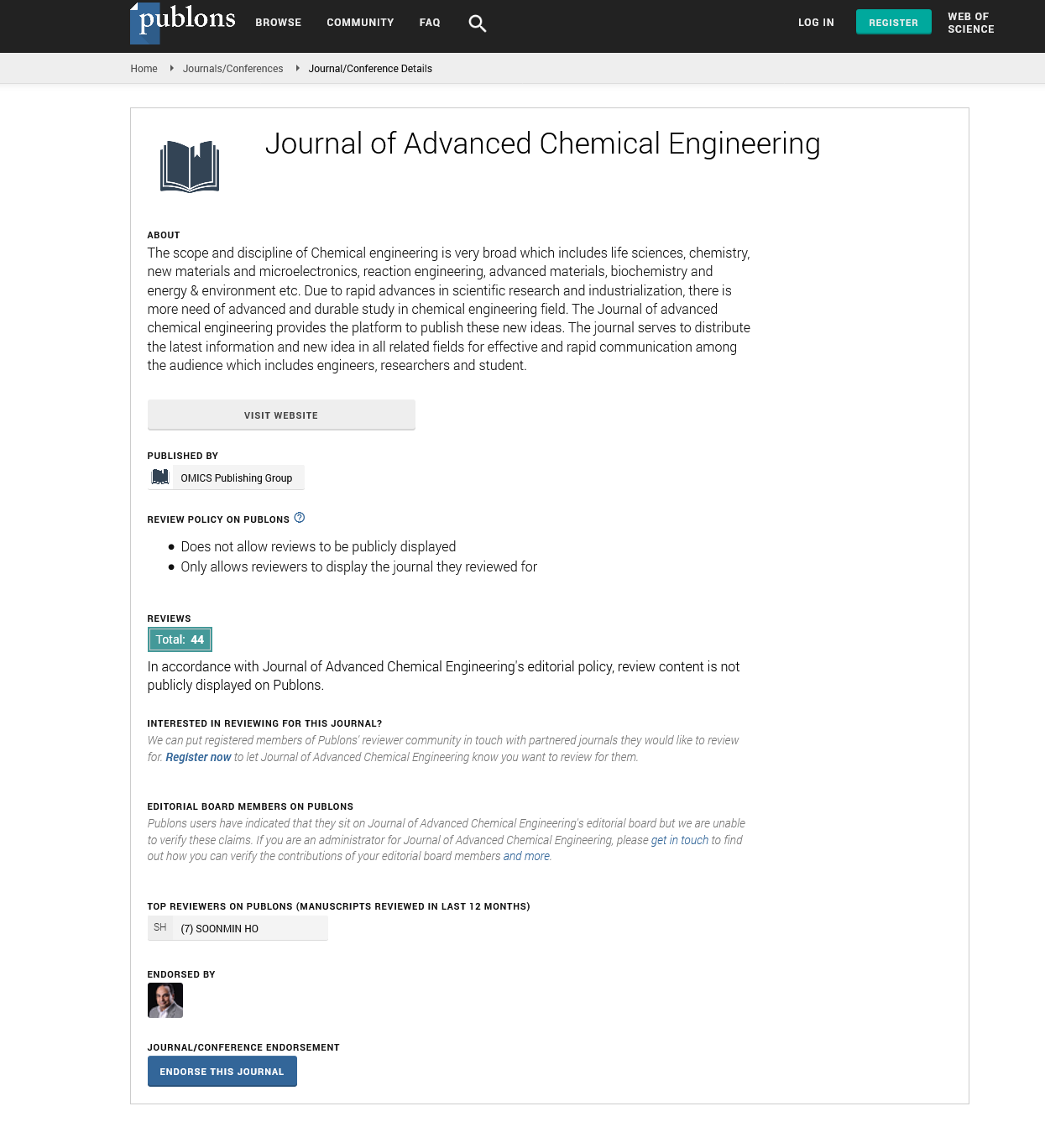Indexed In
- Open J Gate
- Genamics JournalSeek
- Smithers Rapra
- RefSeek
- Directory of Research Journal Indexing (DRJI)
- Hamdard University
- EBSCO A-Z
- OCLC- WorldCat
- Scholarsteer
- Publons
- Geneva Foundation for Medical Education and Research
- Google Scholar
Useful Links
Share This Page
Journal Flyer

Open Access Journals
- Agri and Aquaculture
- Biochemistry
- Bioinformatics & Systems Biology
- Business & Management
- Chemistry
- Clinical Sciences
- Engineering
- Food & Nutrition
- General Science
- Genetics & Molecular Biology
- Immunology & Microbiology
- Medical Sciences
- Neuroscience & Psychology
- Nursing & Health Care
- Pharmaceutical Sciences
Commentary - (2021) Volume 11, Issue 3
Micro Emulsion Polymerization with Surfactants
Satyanarayana DNV*Received: 04-Jul-2021 Published: 26-Jul-2021
Introduction
Over the last few decades, functional polymer colloids generated by emulsion polymerization have been investigated and exploited in biomedical applications at an increasing rate. Micro-emulsions are liquid combinations of water, oil, and a surfactant that reduces the surface tension between the two. Micro-emulsions have unique properties such as large surface area, thermodynamic stability, and low surface tension as a result of their small size, making them extremely useful in areas such as oil recovery, immune-assays, protein adsorbents, enzyme immobilization, drug delivery systems, and as a reaction media for polymerization. Many widely available polymers, such as polyvinyl acetate (PVA), polyvinyl chloride (PVC), and butadiene-styrene copolymers, are synthesized in bulk by micro-emulsion polymerization and are utilized in coatings, adhesives, paints, and biomedical equipment. A polymerization reaction's main goal is to produce a high molecular weight polymer with acceptable mechanical properties, such as elasticity and tensile strength. Micro-emulsion polymerization with a polymerisable surfactant provides improved compatibility and stability to the polymer matrix by becoming a part of it, according to studies. Micro-emulsion-produced hydrophobic polymers have the potential to revolutionise drug release and delivery systems. These hydrophobic polymers include water micro emulsions, are insoluble and have a large chemically active and electrophilic surface area, which aids in drug entrapment. The needed medicine is encapsulated in micro emulsions and then polymerized to encapsulate the drug in a emulsion microcapsule within the polymer during the manufacture of such hydrophobic polymers. Once inside the body, the medication is progressively released through diffusion.
Free Radical Polymerization
The majority of emulsion polymerizations take place via free radical polymerization, though more controlled radical polymerization chemistry is increasingly being used, especially for more specialized applications, and micro-emulsion polymerization has opened up new possibilities, such as the use of poly-condensation and poly-addition. However, in presenting the principles, we will concentrate on free-radical emulsion polymerization because it is the cornerstone for analysing and comprehending the majority of emulsion polymerizations. As a result, we've included a summary of the key characteristics of free-radical polymerization.
Components
In emulsion polymerization, copolymerization is prevalent. In emulsion polymerization, the same laws and co-monomer pairings apply as in radical polymerization. The aqueous solubility of the monomers, on the other hand, has a significant impact on copolymerization kinetics. Monomers with high water solubility are more likely to partition in the aqueous phase rather than in the polymer particle. They won't get incorporated into the polymer chain as easily as monomers with lower water solubility. This can be prevented by utilizing a semi-batch technique to add monomer in a predetermined order. In emulsion polymerization, ethene and other alkenes are utilized as minor co-monomers, particularly in vinyl acetate copolymers.
Initiators
In emulsion polymerization, both thermal and redox production of free radicals have been exploited. In both start modalities, persulfate salts are routinely utilized. Above roughly 50 °C, the persulfate ion quickly breaks down into sulphate radical ions, providing a thermal source of initiation. When a persulfate salt, a reducing agent such as glucose, Rongalite, or sulfite, and a redox catalyst such as an iron compound are all present in the polymerization mix, redox initiation occurs. Temperature is not a constraint in redox recipes, and they are employed for polymerizations that take place below 50 °C. One of the oxidant or reducing agent must be water soluble, in redox initiation.
Surfactants
The correct surfactant must be chosen before any emulsion polymerization process can begin. The surfactant must allow for a rapid polymerization rate, minimize coagulum or fouling in the reactor and other process equipment, avoid an unacceptably high viscosity during polymerization, and maintain or improve final product properties such as tensile strength, gloss, and water absorption. Surfactants that are anionic, non-ionic, and cationic have all been utilized, with anionic surfactants being the most common. Low critical micelle concentration (CMC) surfactants are preferred; when the surfactant level is over the CMC, the polymerization rate increases dramatically, and minimizing the surfactant is desirable for cost reasons and the unfavourable influence of surfactant on the physical qualities of the resultant polymer.
Non-Surfactant Stabilizers
Even though they do not normally form micelles or act as surfactants, some grades of polyvinyl alcohol and other watersoluble polymers can facilitate emulsion polymerization.
Colloidal stability is usually quite good in dispersions made with these stabilizers. However, because of the presence of the water-soluble polymer, they frequently result in products that are extremely water sensitive.
Applications
There are three categories of polymers produced by emulsion polymerization.
Synthetic rubbers: Nitrile rubber, acrylic rubber, fluoroelastomer.
Plastics: polyvinylidene fluoride, polyvinyl fluoride
Dispersions: polyvinyl acetate, polyvinyl acetate co-polymers, polyacrylates, styrene- butadiene, vinyl acetate ethylene copolymers.
Acknowledgments
The authors are grateful to the journal editor and the anonymous reviewers for their helpful comments and suggestions.
Declaration of Conflicting Interests
The authors declared no potential conflicts of interest for the research, authorship, and/or publication of this article.

